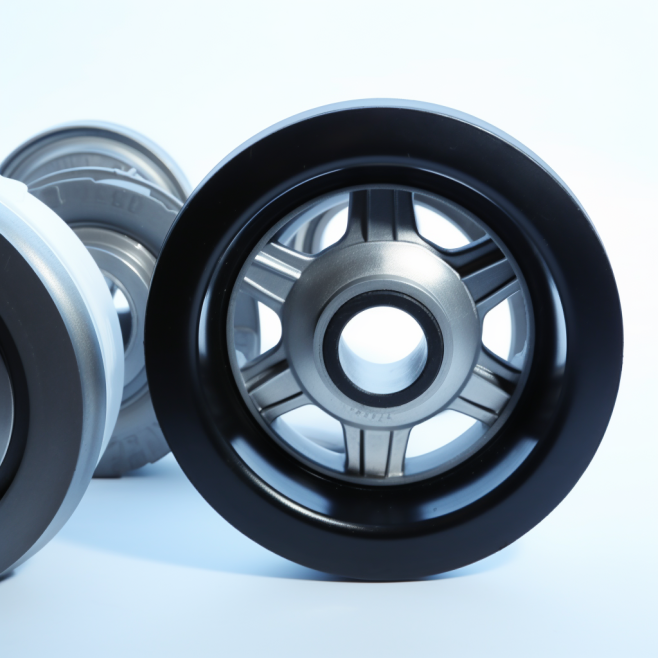Materials of Excellence
Crafting with the Best in the Business
At Julong Rubber, we prioritize using the finest materials to ensure the durability, efficiency, and performance of every product. Explore the various high-quality materials that form the foundation of our premium rubber components.
2.Styrene-Butadiene Rubber(SBR)
The Synthetic Successor to Natural Rubber
Styrene-Butadiene Rubber, commonly referred to as SBR, is a copolymer made from styrene and butadiene. As the most widely used synthetic rubber, SBR offers properties similar to natural rubber but with enhanced resistance to abrasion, wear, and water. Its ability to be tailored during production processes allows for specific performance attributes, making it versatile across various industries.

Styrene-Butadiene Rubber (SBR): Versatility and Applications
Styrene-butadiene rubber, commonly known as SBR, is a synthetic rubber with remarkable versatility. It’s widely used across various industries due to its unique properties and cost-effectiveness.
1. Tire Industry:
SBR is a tire industry staple, often blended with natural rubber. It enhances tire durability, grip, and performance, making it an ideal choice for various road conditions.
2. Footwear:
Many shoe soles are made of SBR due to its abrasion resistance and waterproof qualities. It provides comfort and durability.
3. Automotive Parts:
SBR seals, gaskets, and hoses are crucial for automotive applications. They resist oil, heat, and weather, ensuring long-lasting performance.
4. Construction:
SBR finds its way into construction materials. It’s used in roofing materials, adhesives, and coatings, adding durability and weather resistance.
5. Sporting Goods:
From tennis balls to sports shoe soles, SBR contributes to the production of various sporting goods due to its excellent resilience.
6. Industrial Belts:
SBR-based conveyor belts are vital in manufacturing industries. They offer robust performance in moving heavy materials.
Manufacturing Process:
SBR is made by polymerizing styrene and butadiene. The result is a rubber with a balanced mix of properties, like good aging, abrasion resistance, and flexibility.
Sustainability:
SBR can be recycled and reprocessed, aligning with the growing focus on sustainable materials.
In summary, Styrene-Butadiene Rubber (SBR) is a versatile material with a wide range of applications across industries. Its unique properties and cost-effectiveness make it a popular choice for various products, from tires to shoes, contributing to our daily lives.
SBR vs. Natural Rubber: A Comparison
The dynamic world of rubber materials presents manufacturers with a crucial decision: choosing between Styrene Butadiene Rubber (SBR) and natural rubber. This article undertakes a comprehensive comparison of these two prominent options.
Introduction: Unveiling the Dilemma
The choice between SBR and natural rubber is a significant decision that influences various industries. Both materials possess unique characteristics that cater to different needs, and understanding their differences is pivotal in making an informed choice.
Raw Material Origins: Natural vs. Synthetic
Natural rubber derives from the latex of rubber trees, while SBR is a synthetic product created from styrene and butadiene monomers. Natural rubber’s eco-friendly origin aligns with sustainability goals, while SBR’s synthetic nature offers flexibility in tailoring properties.
Properties: Durability and Performance
Natural rubber boasts exceptional elasticity, tear resistance, and low heat buildup. Its performance in applications like tires and conveyor belts is notable. Conversely, SBR exhibits enhanced abrasion resistance and toughness, making it suitable for tire treads and footwear soles.
Cost-Effectiveness: A Balancing Act
SBR’s synthetic production process often leads to cost advantages. Natural rubber’s price can be influenced by factors like weather and supply. SBR’s affordability makes it an attractive choice for industries focused on cost-effectiveness.
Environmental Impact: Green Choices
Natural rubber’s renewable origin positions it as an environmentally friendly option, aligning with sustainability initiatives. SBR’s synthetic nature requires energy-intensive production processes but offers opportunities for eco-friendly formulations.
Weather Resistance: Facing the Elements
Natural rubber’s susceptibility to degradation from sunlight and ozone prompts the need for additives in some applications. SBR’s good weathering properties resist environmental stressors, enhancing its suitability for outdoor applications.
Versatility and Customization: Tailoring Properties
SBR’s synthetic nature allows for precise customization of properties such as hardness, resilience, and abrasion resistance. Natural rubber, while versatile, may require more elaborate processing to achieve specific characteristics.
Latex Allergies: Safety Considerations
Natural rubber can trigger latex allergies in some individuals, leading to the need for latex-free alternatives. SBR offers a safer option for those with latex sensitivities, making it a preferred choice in applications like healthcare.
Eco-Friendly Formulations: Sustainability’s Path
SBR’s synthetic origins haven’t hindered efforts to create eco-friendly formulations. Bio-based or recycled materials are being integrated into SBR, aligning it with sustainability goals.
Conclusion: A Complex Equation
The SBR vs. natural rubber debate is a nuanced one, dependent on factors ranging from application requirements to sustainability goals. Both materials possess advantages that cater to specific industry needs, and the decision ultimately hinges on understanding these nuances.
In conclusion, the comparison between SBR and natural rubber underscores the intricacies of material selection. Natural rubber’s renewable origin and unique properties complement SBR’s adaptability, cost-effectiveness, and customization potential. Manufacturers must carefully weigh these factors to make informed choices that align with performance objectives, environmental consciousness, and industry demands.
Custom Rubber Parts with Easy
At Julong Rubber, We turn complex Into Simple! Follow the following 3 steps to start today!

Tell Us What You Need
Tell us as specific as possible of your needs, provide the drawing, reference picture and share your idea.

Get Solution & Quote
We will work on the best solution according to your requirements and drawing, the specific quote will be provided within 24 hours.

Approve for Mass Production
We will start mass production after getting your approval and deposit, and we will handle the shipment.

Get A Free Quote
Contact us to get a free quote and more expertise about custom rubber parts. Your project will meet the right solution at Julong Rubber.
Email:info@rubberandseal.com


